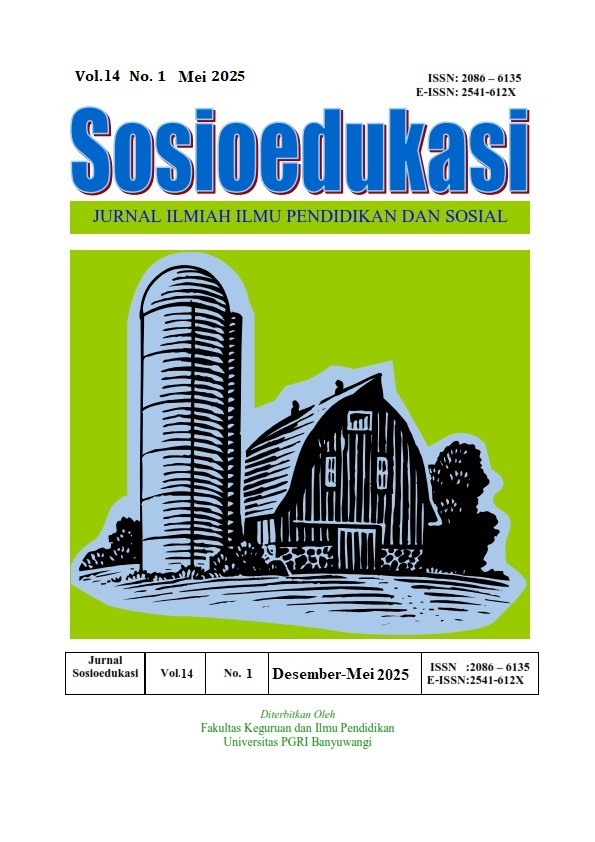THE LINGUISTIC CREATIVITY AND ITS IMPACT ON LOCAL ECONOMIC POTENTIAL AND GLOBAL INCOME
DOI:
https://doi.org/10.36526/sosioedukasi.v14i1.5661Keywords:
Restaurant naming; linguistic creativity; cultural identity; branding strategies; ManadoAbstract
This study examines the linguistic creativity in the naming practices of restaurants in Manado, Indonesia, focusing on the influence of local culture, language, and global trends. The research analyzes a sample of 230 restaurant names to explore the types of languages used, including Indonesian, local dialects, foreign languages, and hybrid combinations. The findings show that Indonesian names dominate the market, making up 51.3% of the total sample, followed by foreign language names at 16.1%, and local dialect names at 12.2%. Hybrid names combining local and foreign elements account for 32.2% of the total, reflecting a blending of local and global influences in Manado's culinary scene. The study also explores the use of linguistic strategies such as wordplay, alliteration, and metaphors, highlighting their role in shaping brand identities and consumer perceptions. These creative strategies not only enhance brand recall but also serve as powerful tools for differentiation in a competitive market. The research emphasizes the significance of cultural and regional factors in shaping naming trends, with local dialects and cultural references playing a central role in creating authentic and relatable brands. It also compares the naming practices in Manado with those in other regions, suggesting that while global influences are present, the local culture remains a key element in restaurant branding. The paper concludes with practical implications for restaurant owners and marketers, providing insights into effective naming strategies to attract and engage customers. The study further identifies limitations, such as its sample size and geographic scope, and suggests areas for future research, including expanding the study to other cities or focusing on specific restaurant types.
References
Asad, M. M., Naz, A., Churi, P., Guerrero, A. J. M., & Salameh, A. A. (2022). Mix method approach of measuring VR as a pedagogical tool to enhance experimental learning: Motivation from literature survey of previous study. Education Research International, 2022(1), 8262304.
Barbosa, B., Shabani Shojaei, A., & Miranda, H. (2023). Packaging-free practices in food retail: the impact on customer loyalty. Baltic Journal of Management, 18(4), 474–492. https://doi.org/10.1108/bjm-10-2022-0386
Choi, J., & Seo, S. (2021). Do brand rumors matter? The role of brand equity and response strategy to brand rumor. International Journal of Contemporary Hospitality Management, 33(8), 2862–2879. https://doi.org/10.1108/ijchm-01-2021-0054
Deng, Y.-Y., & Yang, Y.-C. (2021). Exploring the role of green attributes transparency influencing green customer citizenship behavior. British Food Journal, 124(5), 1473–1484. https://doi.org/10.1108/bfj-03-2021-0223
Dsouza, D., & Sharma, D. (2020). Online food delivery portals during COVID-19 times: an analysis of changing consumer behavior and expectations. International Journal of Innovation Science, 13(2), 218–232. https://doi.org/10.1108/ijis-10-2020-0184
Fahmi, F. Z., Ramadhani, D., Aritenang, A. F., & Dwicahyani, A. A. (2021). Informality and the branding of creative places: the case of Suci screen-printing kampong in Bandung, Indonsia. International Development Planning Review, 43(1), 89–113. https://doi.org/10.3828/idpr.2019.38
Gu, Q., Huang, S. (Sam), & Li, M. (2022). An exploratory investigation of technology-assisted dining experiences from the consumer perspective. International Journal of Contemporary Hospitality Management, 35(3), 1010–1029. https://doi.org/10.1108/ijchm-02-2022-0214
Gupta, O. J., Yadav, S., Srivastava, M. K., Darda, P., & Mishra, V. (2024). Understanding the intention to use metaverse in healthcare utilizing a mix method approach. International Journal of Healthcare Management, 17(2), 318–329.
Harba, J.-N., Davidescu, A. A., & Tigu, G. (2021). Exploring Consumer Emotions in Pre-Pandemic and Pandemic Times. A Sentiment Analysis of Perceptions in the Fine-Dining Restaurant Industry in Bucharest, Romania. International Journal of Environmental Research and Public Health, 18(24), 13300. https://doi.org/10.3390/ijerph182413300
Hay, N. A., Chien, P. M., & Ruhanen, L. (2021). Tell me your story: Branding destinations through residents’ place stories. Journal of Vacation Marketing, 28(3), 319–334. https://doi.org/10.1177/13567667211060567
Huang, C.-C., & Chen, S.-E. (2021). Establishing and Deepening Brand Loyalty through Brand Experience and Customer Engagement: Evidence from Taiwan’s Chain Restaurants. Journal of Quality Assurance in Hospitality & Tourism, 23(1), 217–239. https://doi.org/10.1080/1528008x.2020.1864565
Jeong, M., Kim, K., Dipietro, R., & Ma, F. (2021). Key factors driving customers’ restaurant dining behavior during the COVID-19 pandemic. International Journal of Contemporary Hospitality Management, 34(2), 836–858. https://doi.org/10.1108/ijchm-07-2021-0831
Karagiannis, D., & Andrinos, M. (2021). The Role of Sustainable Restaurant Practices in City Branding: The Case of Athens. Sustainability, 13(4), 2271. https://doi.org/10.3390/su13042271
Leung, R., & Loo, P. T. (2020). Co-creating interactive dining experiences via interconnected and interoperable smart technology. Asian Journal of Technology Innovation, 30(1), 45–67. https://doi.org/10.1080/19761597.2020.1822748
Lin, P. M. C. (2021). Dining in the sharing economy: a comparison of private social dining and restaurants. International Journal of Contemporary Hospitality Management, 34(1), 1–22. https://doi.org/10.1108/ijchm-12-2020-1453
Madanaguli, A., Dhir, A., Kaur, P., Srivastava, S., & Singh, G. (2022). Environmental sustainability in restaurants. {A} systematic review and future research agenda on restaurant adoption of green practices. Scandinavian Journal of Hospitality and Tourism, 22(4–5), 303–330. https://doi.org/10.1080/15022250.2022.2134203
Madeira, A., Palrão, T., Mendes, A. S., & Ottenbacher, M. C. (2021). The culinary creative process of Michelin Star chefs. Tourism Recreation Research, ahead-of-p(ahead-of-print), 258–276. https://doi.org/10.1080/02508281.2021.1958170
Remar, D., Bilgihan, A., & Sukhu, A. (2021). The effects of environmental consciousness and menu information on the perception of restaurant image. British Food Journal, 124(11), 3563–3581. https://doi.org/10.1108/bfj-06-2021-0666
Rita, P., Pinheiro, F., Mimoso, J., & Vong, C. (2022). A sentiment analysis of Michelin-starred restaurants. European Journal of Management and Business Economics, 32(3), 276–295. https://doi.org/10.1108/ejmbe-11-2021-0295
Safeer, A. A., & Liu, H. (2022). Role of corporate social responsibility authenticity in developing perceived brand loyalty: a consumer perceptions paradigm. Journal of Product & Brand Management, 32(2), 330–342. https://doi.org/10.1108/jpbm-01-2022-3807
Swink, M., Hu, K., & Zhao, X. (2022). Analytics applications, limitations, and opportunities in restaurant supply chains. Production and Operations Management, 31(10), 3710–3726. https://doi.org/10.1111/poms.13704
Yunpeng, S., & Khan, Y. A. (2021). Understanding the effect of online brand experience on customer satisfaction in China: a mediating role of brand familiarity. Current Psychology, 42(5), 3888–3903. https://doi.org/10.1007/s12144-021-01706-7









.png)

















